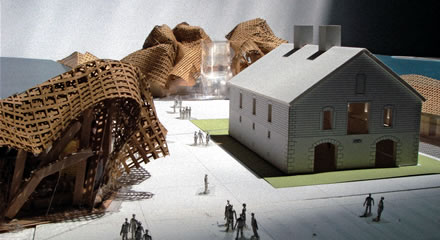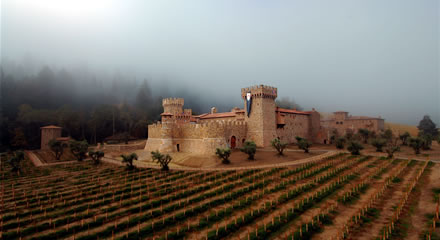
|
|
PRINT » |
|
|
E-MAIL THIS PAGE » |
|
|
CLOSE THIS WINDOW » |
Feature Article from the October 2008 Magazine Issue
Trends in Winery Construction
Estate wineries still being built; alternate business plans abound

PHOTO: Gehry Partners
All of these trends and more turn out to be important factors in wine facility construction. There are still wineries being launched the old-fashioned way: Someone buys land, plants grapes, builds a winery, makes wine and sells wine. But alongside that time-honored model are a host of alternative ways to enter the wine business -- rom virtual wineries to "wine country lifestyle" endeavors, in which the wine itself isn't the main point.
Just as there's a whole new world of wine out there, there's a whole new world of winery construction.
Napa/Sonoma dynamics
Any story about the state of the U.S. wine business eventually becomes two stories: one is about Napa and Sonoma counties, and another covers the rest of the country. Winery construction is no exception.
In the heart of the ultra-premium wine country, entry costs for starting a winery on the old model are astronomical. Most of the good land already is occupied, and county-level growth controls put a damper on freewheeling development. So instead of a raft of new projects, Napa and Sonoma's construction scene is more about retrofitting for brand consolidation and expansion, and the proliferation of custom-crush arrangements -- punctuated by the occasional showpiece.
The recent wave of industry consolidation means that the major wine and spirits conglomerates are purchasing, trading and renovating existing production facilities -- not, for the most part, building new ones. At least that's the opinion of John Shook, general manager of Nordby Wine Caves, who is headquartered in Santa Rosa, Calif., and works mainly in the North Coast, Oregon and Washington.
"Winery construction isn't booming," Shook says, "but there are a lot of remodels. We get calls about adding this or that, changing the ventilation, moving the fermentation space into the caves -- not necessarily new construction, but upgrades. People with existing facilities want to add to the product mix."
Keith Burnham, director of preconstruction for James Nolan Construction in Napa (and its sister company, Hearn Construction in Vacaville, Calif.), sees something similar. "Business is booming," he says, "but not necessarily on the wine side, more on hospitality.
"Napa has a 40-acre minimum site limit; there's less land available, and land values are still very high for a start-up," Burnham says. "There's more work for consolidation, reimaging, rebranding."
Architect Scott Bartley of Hall and Bartley in Santa Rosa finds expansion going on mainly among medium-sized wineries in the 20,000- to 100,000-case range, not the Beringers of the region.
The equipment business is another good indicator of construction trends, and Emanuele Fiorentini of AWS/Propsero in Windsor, Calif., sees wineries adding tanks, buying larger bottling lines, expanding into screwcaps and -- especially in Sonoma -- outfitting for custom-crush operations.
Jeff Goodwin of BAR Architects in San Francisco spots a lot of activity in renovation of historic structures in the North Coast wine country, places that have instant charm and -- even better -- already have use permits.
The proliferation of custom-crush operations and labels has been an ongoing trend in Napa and Sonoma for several years. These facilities, catering to the industry rather than the public, tend to be functional and warehouse-like -- not statement buildings, which translates not only into less construction but far less investment in architecture and design. Co-op tasting rooms, which do hope to entice consumers, require more inspiration and imagination, but they are small projects in the grand scheme of things.
But rest assured, Napa showpieces on the grand scale aren't dead, they're just less numerous. Napa is still digesting last year's opening of Castello di Amorosa, the 121,000-square-foot, 107-room, "12th century" castle/winery hand-built during the past 15 years by V. Sattui Winery owner Dario (Darryl) Sattui and a phalanx of European master artisans.

PHOTO: Vern Nelson
Construction is well under way on what is bound to be a tour-bus destination, the new Frank Gehry-designed Hall Winery in St. Helena, due in 2010. Nearly everyone I talked to had some amount of new construction projects somewhere in their pipelines. BAR's Goodwin notes that a lot of people are sitting out the recession by concentrating on the time-consuming but relatively less expensive process of permitting and entitlement, with hopes of building when times get better.
He notes that recession or no recession, boutique winery or major player, "the trend in Napa and Sonoma is still more toward the high-end, branded wineries and facilities. Other places, folks want what Napa wanted 20 years ago -- more focus on production, less on branding."
Elsewhere in the wine world
Oregon's Willamette Valley and Washington's Columbia/Yakima/Walla Walla region are similar to California's North Coast in that they represent relatively mature wine regions and exhibit many of the same trends in construction as Napa and Sonoma.
Larry Ferar, a Portland-based architect specializing in winery projects, says that to his surprise, he has more work than usual, despite the recession. "It may still be the 'Sideways'-Pinot Noir phenomenon," he speculates.
But that work tends to be expansions and remodels rather than entirely new construction. The two new wineries he's currently working on are projects launched before the economy went sour.
Some Oregon brands are expanding quite rapidly, and the big players are picking up smaller labels in Washington at attractive prices. Smaller start-ups, however are holding back. The slack is being taken up by custom-crush facilities and cooperative endeavors with several wineries operating under one roof.

Bonnie Hampton, program manager for the New York Wine and Grape Foundation, notes that state and local laws and regulation encourage stand-alone wineries and make custom-crush complicated. Part of her job is monitoring new use permit applications in the state, and when she reviews them every few weeks, there are always three or four new ones on the books.
Paso Robles, San Luis Obispo and Santa Barbara, on California's Central Coast, still are absorbing a huge increase in planted acreage over the past decade, some of which hasn't yet come online. Besides selling grapes to wineries outside the region, the Paso/SLO area shows a mix of well-heeled new ventures and custom-crush start-ups. Jim Viale of Paso Robles Tank sees the familiar pattern: Deep-pocketed projects are going ahead, with facilities to match, and shallower-pocketed players band together to fill semi-industrial spaces in places like Lompoc, where half a dozen labels can share the costs of one wastewater system and one ecumenical tasting room.
Building lifestyle experiences
Paso Robles is doing something else that has a construction angle: branding the region as a tourist magnet. Many local businesses are united in seeking to integrate historical traditions, rural feel and the burgeoning wine industry into one coherent, irresistible image that will make Paso a travel destination.
One of the most happening places in the nationwide wine country is Southern California's Temecula Valley.
The presence of 23 million thirsty residents in the Los Angeles/San Diego megaplex, all wanting a relaxing day out among the vines, have sent Temecula into expansion overdrive. New vineyards are being planted and wineries launched, often in conjunction with extra amenities -- restaurants, guest rooms -- to make the drive worthwhile.
Denis Ferguson, a local developer and chair of the Convention & Visitors Bureau, says the new wine-focused projects in Temecula "have the additional advantage of being able to project the complete wine country experience: winemaking, food, sleeping among the vines, catering, weddings, reunions. You can't do all those things in one place in Napa," Ferguson says.
The Temecula surge started with the Pechanga Resort and Casino, accelerated with the South Coast Winery, Resort and Spa about five years ago and hasn't looked back.
Ferguson is at work on his own Europa development -- a complex that will contain three wineries, two restaurants, 60 guest rooms and resort amenities -- connected to an estate community of high-end homes surrounded by vineyards. The rate of growth has been high enough to draw attention from Riverside County officials, who are working to develop some kind of master plan to balance growth and maintain the agricultural character of the area.
Of course, there's no reason the wine country lifestyle has to be limited to California. Developer Jim Fleig recently poured concrete retaining walls for an $11 million project in Branson, Mo., which is better known as a mecca for country music tourism.
Fleig says, "I'm not a wine guy, I'm a developer. Most people who build wineries are either already in the grape business or driven by ego. I'm doing this to make money." The basic premise is to take the winery to where the tourists already are, not make them come to the winery. Branson Ridge, due to open June 2009, will have a bistro, a pond, verandas overlooking t he vines, a golf course across the street, chef demonstrations and other food amenities. In full swing, it also will sell 400,000 bottles of wine per year, mainly from purchased grapes; the on-site vineyards are there for ambience.
Fleig calls the concept behind the project "experiential retailing."
| Abbot Painting & Coatings (707) 763-3717 abbotcoatings.com |
Jacobs Associates (415) 434-1822 jacobssf.com |
| Anderthal Wine Caves (707) 744-1100 anderthal.com |
Knights' Electric Inc. (707) 433-6931 knightselectric.com |
| Arxx Building Products (905) 373-0004 arxxbuild.com |
Ledcor Construction (858) 527-6400 ledcor.com |
| Lloyd W. Aubry Co. Inc. (510) 732-9038 lloydwaubry.com |
Magorian Mine Services (530) 269-1960 magmineserv.com |
| BU Corp Inc. (843) 722-0308 b-ucorp.com |
Matheny Industrial Builders (209) 571-5020 mathenyindustrial.com |
| Barrier Specialty Roofing & Coatings (877) 233-2003 barrierroofing.com |
Mill Construction (831) 424-0781 millconstruction.com |
| Bruner Corp. (614) 334-9000 brunercorp.com |
Mountain States Construction Co. (509) 837-6822 mtstates.com |
| Alf Burtleson Construction (707) 963-2916 alfburtlesonconstruction.com |
Jim Murphy & Associates (707) 576-7337 j-m-a.com |
| Cal Inc. (800) 359-4467 cal-inc.com |
James Nolan Construction Inc. (707) 963-3222 jnc-construction.com |
| Condor Earth Technologies (209) 532-0361 condorearth.com |
Nonella Construction (707) 544-8080 nonella.com |
| Construction Management Solutions Inc. (CMS) (804) 275-5330 cmsbuildersolutions.com |
Nordby Wine Caves (707) 526-4500 nordby.net |
| CONTECH Construction Products (513) 645-7000 contech-cpi.com |
Pacific Wineries (503) 419-7942 pacificwineries.net |
| Corey Delta Constructors (707) 747-7500 coreydelta.com |
Petrochem Insulation (707) 644-4908 petrocheminc.com |
| Dynamic Coatings Inc. (559) 225-4605 dynamiccoatingsinc.net |
Phoenix Coatings Inc. (559) 675-8122 phoenixcoatings.com |
| Foodpro International Inc. (408) 227-2332 foodpro.net |
Ryan Associates (415) 861-3085 ryanassociates.com |
| Gilbert Project Services (706) 348-1622 gilbertprojectservices.com |
Summit Engineering Inc. (707) 527-0775 summit-sr.com |
| Hanson Spancrete Pacific (626) 962-8751 hansonstructural.com/home.html |
Swi-Co Construction (707) 542-5464 swicoconstruction.com |
| Idiaz Services (707) 473-9353 idiazservices.com |
UCI Construction (800) 245-6750 uciconstruction.com |
| Indoor Environmental Services (916) 988-8808 ies-hvac.com |
Wright Contracting Inc. (707) 528-1172 wrightcontracting.com |
| Integrated Structures Inc. (510) 665-9633 integratedstructures.com |
Zucco Fagent Associates Structural Engineers (707) 5260992 zfa.com |
|
|
PRINT » |
|
|
E-MAIL THIS ARTICLE » |
|
|
CLOSE THIS WINDOW » |
